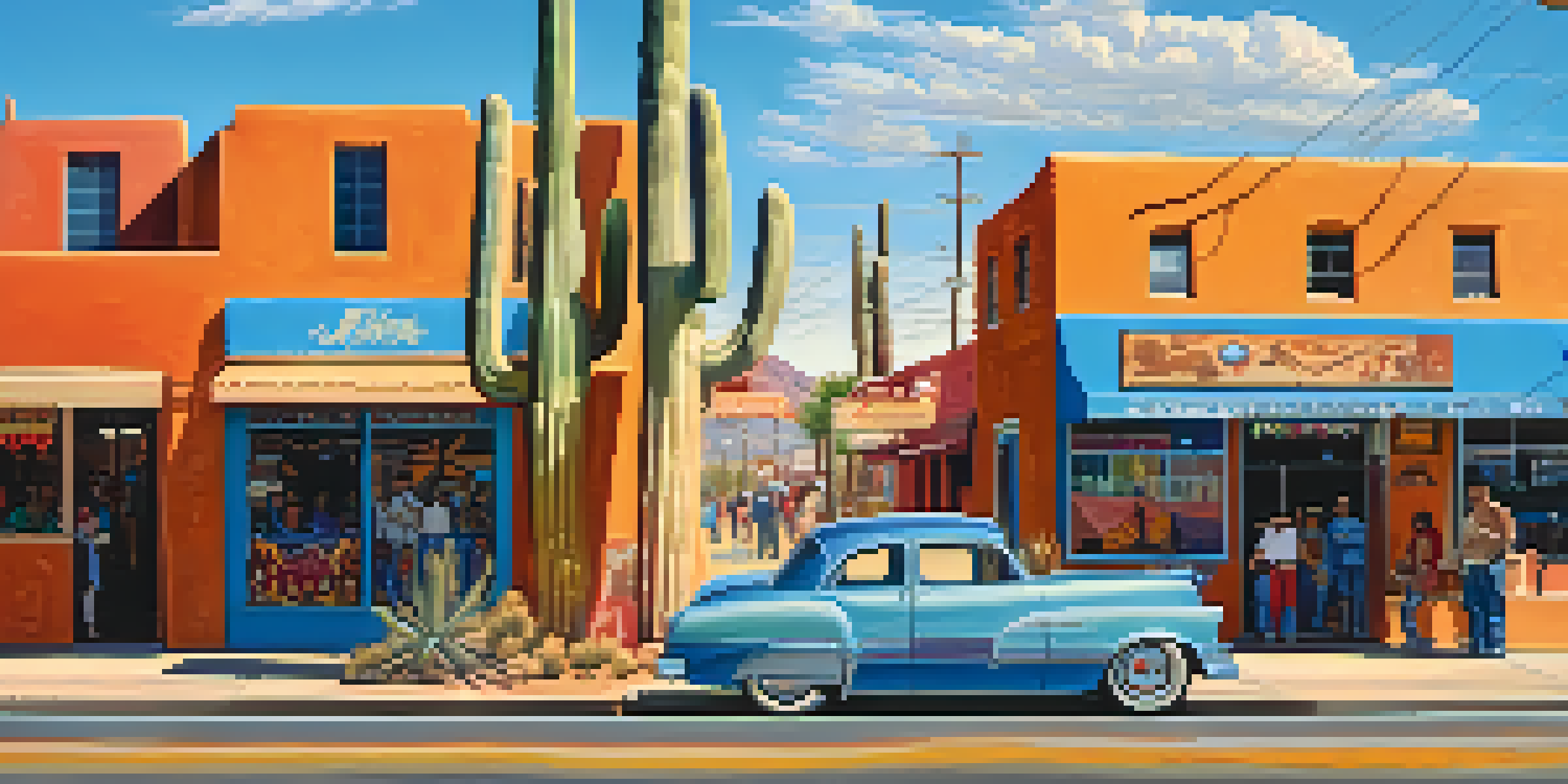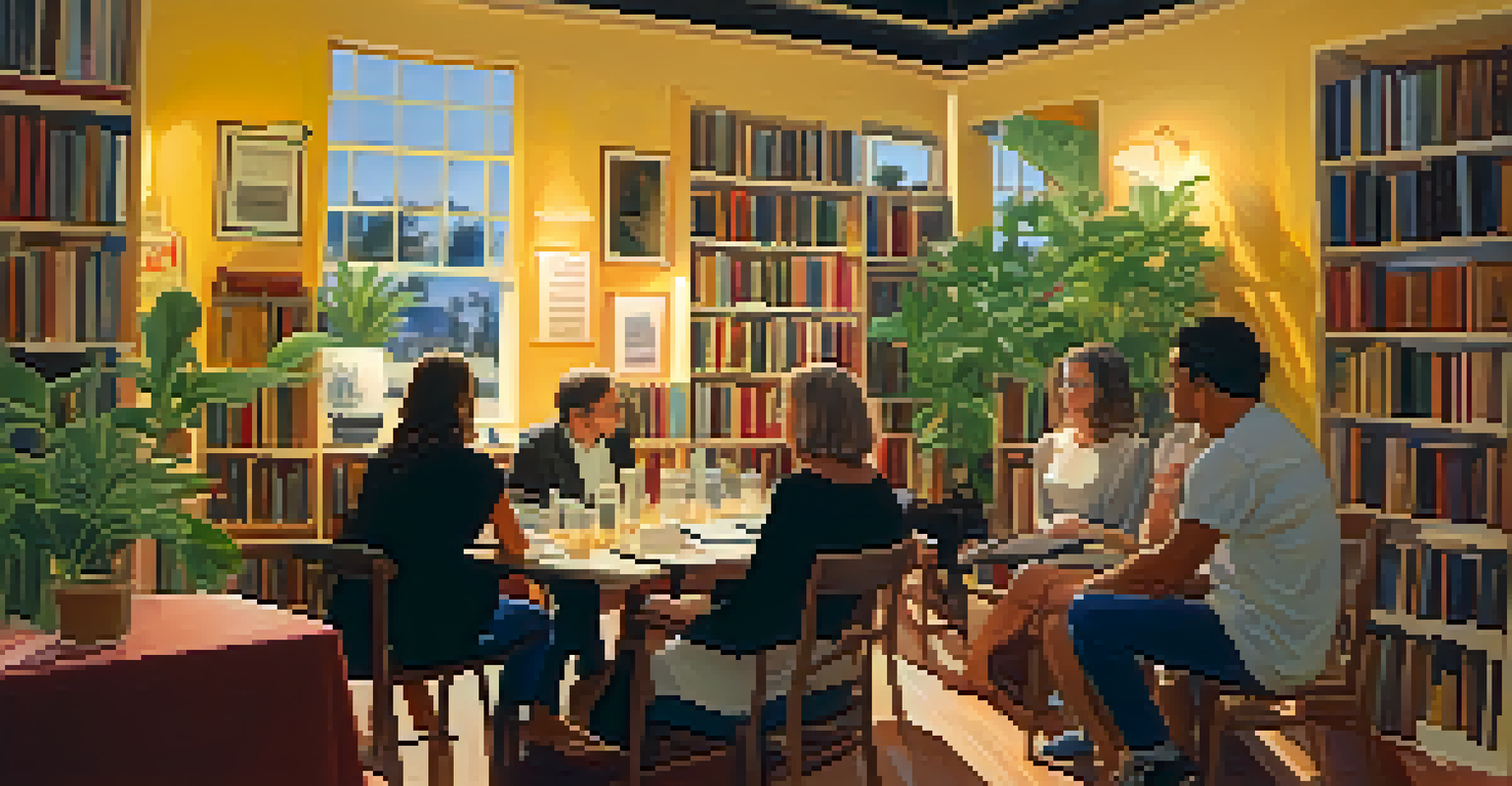Tucson's Cultural Melting Pot: A Literary Analysis

Introduction to Tucson's Cultural Landscape
Tucson, Arizona, is often described as a cultural melting pot, where diverse influences converge. This vibrant city boasts a rich tapestry shaped by Native American, Hispanic, and Anglo communities, each contributing unique narratives. The result is a literary scene that reflects the city's multifaceted identity, inviting readers to explore its depths.
Literature is the most agreeable way of ignoring life.
Through literature, Tucson's cultural complexity comes alive, offering a microcosm of broader societal themes. Writers draw inspiration from the city’s landscapes, history, and people, creating works that resonate universally while also highlighting local nuances. This blend of perspectives fosters a sense of belonging and pride among its inhabitants.
As we delve into Tucson's literary contributions, we uncover the stories that not only entertain but also educate and inspire. These narratives serve as a bridge to understanding the intricate relationships between different cultures, making Tucson an essential focal point in American literature.
The Influence of Indigenous Narratives
Indigenous cultures have profoundly shaped Tucson's literary scene, with their stories woven into the fabric of the city. Native American authors bring forth unique perspectives, often addressing themes of identity, land, and spirituality. Their works serve as a reminder of the deep-rooted connections to the land and the rich oral traditions that have persisted through generations.

Incorporating indigenous narratives into the broader literary discourse not only honors these voices but enriches the cultural landscape. Writers like Linda Hogan and Leslie Marmon Silko have highlighted the importance of indigenous experiences and the ongoing struggles for recognition and rights. Their stories resonate deeply with local communities while also reaching a global audience.
Cultural Diversity Shapes Literature
Tucson's literary scene is enriched by the diverse contributions of Indigenous, Hispanic, and Anglo authors, reflecting the city's multifaceted identity.
By embracing these narratives, Tucson's literary scene fosters a more inclusive understanding of its history and cultural identity. This acknowledgment allows readers to appreciate the complexities of life in Tucson, bridging the gap between past and present.
Hispanic Heritage and Literary Expression
Tucson's Hispanic heritage plays a crucial role in its literary expression, with many authors drawing from their cultural roots. The blending of Spanish and English in these works reflects the city's bilingual nature, creating a distinctive voice that speaks to both local and wider audiences. This cultural fusion enhances the richness of Tucson's literature, making it a unique destination for literary exploration.
The books that the world calls immoral are the books that show the world its own shame.
Writers like Ana Castillo and Alberto Ríos have captured the essence of life in Tucson, portraying the vibrant community, traditions, and struggles of their people. Their narratives often explore themes of belonging, migration, and the quest for identity, resonating with readers from various backgrounds. Through these stories, the complexities of the Hispanic experience in Tucson are brought to light.
The celebration of Hispanic heritage in literature fosters a deeper appreciation for the cultural diversity that defines Tucson. By showcasing these voices, the literary landscape becomes a powerful medium for understanding and connecting with the community.
The Role of Anglo Influences in Tucson Literature
While Tucson's literary scene is deeply enriched by its indigenous and Hispanic roots, Anglo influences also play a significant role. Writers from this background have contributed to the city's narrative, often exploring themes of exploration, frontier life, and the American experience. Their works offer a different lens through which to view Tucson's evolution over the years.
Authors such as Edward Abbey and Barbara Kingsolver have captivated audiences with their vivid depictions of the Southwest. Abbey's environmental activism and Kingsolver's focus on social issues resonate with both local and global readers, highlighting the importance of place in their narratives. These stories often intertwine with the cultural threads already present, creating a cohesive literary tapestry.
Themes of Identity and Belonging
The exploration of identity and belonging is central to Tucson's literature, inviting readers to connect with their own experiences in a multicultural society.
This intermingling of Anglo perspectives with other cultural narratives enriches Tucson's literature. It fosters a dialogue between different communities, encouraging mutual understanding and respect for each other’s stories.
Exploring Themes of Identity and Belonging
Central to Tucson's literature is the exploration of identity and belonging, themes that resonate across cultures. Many authors reflect on their personal experiences in relation to the city’s diverse landscape, examining how culture shapes individual and collective identities. This introspective journey often leads to broader discussions about what it means to belong in a multicultural society.
In their works, authors examine the intersections of race, gender, and heritage, revealing the complexities that arise from these identities. Stories of migration, assimilation, and cultural pride highlight the struggles and triumphs faced by individuals within the community. This focus on identity not only enriches the narratives but also invites readers to reflect on their own experiences.
By addressing these themes, Tucson's literature serves as a mirror for readers, encouraging empathy and understanding. It reminds us that while our backgrounds may differ, the quest for identity is a universal journey.
The Impact of Local Events on Literature
Tucson's literary scene is closely tied to the city's events and cultural happenings, which often inspire writers to reflect on current issues. From the annual Tucson Festival of Books to local art exhibitions, these events create a dynamic environment that fosters creativity and collaboration. Writers are encouraged to engage with the community, leading to literature that is both timely and relevant.
Local events often serve as platforms for authors to share their work and connect with readers. These interactions not only promote literary appreciation but also provide a space for discussions around important social topics. As writers respond to the challenges and triumphs of their surroundings, their works become a reflection of the community's spirit.
Local Events Inspire Literary Works
Community events in Tucson foster creativity among writers, leading to literature that is timely, relevant, and deeply connected to the local spirit.
This synergy between local events and literature contributes to Tucson's unique identity as a cultural hub. It highlights the importance of community engagement in shaping narratives that resonate with both residents and visitors alike.
Conclusion: Celebrating Tucson's Literary Diversity
Tucson's literary scene is a vibrant tapestry woven from the threads of its diverse cultures. The interplay of indigenous, Hispanic, and Anglo narratives creates a rich literary landscape that reflects the city's complexities. By celebrating these voices, Tucson acknowledges its past and embraces its future, inviting readers to explore the stories that define this unique place.
As we have seen, literature serves as a powerful tool for understanding and connecting with different cultures. The themes of identity, belonging, and local influence enrich the narratives, making them accessible to a broader audience. Tucson’s literary contributions remind us of the importance of storytelling in fostering empathy and social awareness.

In conclusion, Tucson stands as a testament to the beauty of cultural diversity and the power of literature to bridge divides. By engaging with these stories, readers can appreciate the richness of Tucson's heritage and the ongoing dialogue between its vibrant communities.